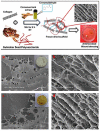Emerging applications of 3D engineered constructs from plant seed extracts
- PMID: 37529162
- PMCID: PMC10388042
- DOI: 10.55730/1300-0152.2645
Emerging applications of 3D engineered constructs from plant seed extracts
Abstract
Seeds, by-products derived from various plants such as mango, quince, and apples, are considered waste, though they have emerging commercial potential, and have been used in biological, industrial, and physiological research. Seed-derived natural macromolecules- mainly polysaccharides, mucilage, gums, and cellulose-have physicochemical and structural diversification, giving the potential for forming gels, texturing, thickening, and providing interfacial adsorption. Seed-derived natural macromolecules have been widely used during the last few years in cell research and tissue engineering applications. Their widespread approachability and safety, high rate of biodegradability, biocompatibility, supporting cell proliferation, and extracellular matrix synthesis are the main properties making plant seed derivatives appropriate for use. The gel-forming ability of these derivatives gives them the capability of creating natural polymer-based scaffolds with the aptitude to resemble extracellular matrices (ECM). These ECM exhibit the high potential in scaffolds for tissue renewal. A deeper knowledge of the physicochemical characteristics of seed-derived mucilage and gum has been indicated as a key ingredient in several pharmaceutical preparations, but it has been remarkably utilized in nanomedicine for the last few years as a drug carrier for drug delivery, in gene therapy, and as scaffold components for tissue engineering purposes. Here, we afford up-to-date data about the different extracts from plant seeds-mainly mucilage and gum, we summarize the extraction techniques used to isolate these macromolecules, and we focus on their application in scaffold fabrication for tissue engineering purposes and regenerative medicine applications.
Keywords: Seed-extract; natural macromolecules; scaffolds; tissue engineering.
© TÜBİTAK.
Figures






Similar articles
-
Glucuronoxylan-based quince seed hydrogel: A promising scaffold for tissue engineering applications.Int J Biol Macromol. 2021 Jun 1;180:729-738. doi: 10.1016/j.ijbiomac.2021.03.096. Epub 2021 Mar 21. Int J Biol Macromol. 2021. PMID: 33757854
-
Quince seed mucilage-based scaffold as a smart biological substrate to mimic mechanobiological behavior of skin and promote fibroblasts proliferation and h-ASCs differentiation into keratinocytes.Int J Biol Macromol. 2020 Jan 1;142:668-679. doi: 10.1016/j.ijbiomac.2019.10.008. Epub 2019 Oct 14. Int J Biol Macromol. 2020. PMID: 31622718
-
Plant-Based Gums and Mucilages Applications in Pharmacology and Nanomedicine: A Review.Molecules. 2021 Mar 22;26(6):1770. doi: 10.3390/molecules26061770. Molecules. 2021. PMID: 33809917 Free PMC article. Review.
-
Seed mucilage-based advanced carrier systems for food and nutraceuticals: fabrication, formulation efficiency, recent advancement, challenges, and perspectives.Crit Rev Food Sci Nutr. 2024 Jul;64(21):7609-7631. doi: 10.1080/10408398.2023.2188564. Epub 2023 Mar 15. Crit Rev Food Sci Nutr. 2024. PMID: 36919601 Review.
-
Injectable chitosan-quince seed gum hydrogels encapsulated with curcumin loaded-halloysite nanotubes designed for tissue engineering application.Int J Biol Macromol. 2021 Apr 30;177:485-494. doi: 10.1016/j.ijbiomac.2021.02.113. Epub 2021 Feb 20. Int J Biol Macromol. 2021. PMID: 33621578
References
-
- Abbastabar B, Azizi MH, Adnani A, Abbasi S. Determining and modeling rheological characteristics of quince seed gum. Food Hydrocolloids. 2015;43:259–264. doi: 10.1016/j.foodhyd.2014.05.026. - DOI
-
- Aktaş R, Kasap H, Dulger E. Economic and Environmental Impacts of Biogas. Journal of Agriculture Machinery Science. 2012;8(3):271–277.
LinkOut - more resources
Full Text Sources
